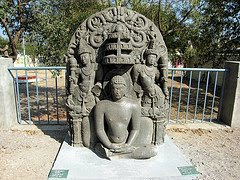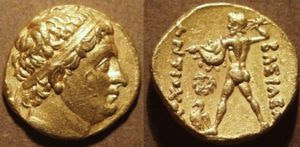 However, during the time it was available, many other Greek writers quoted passages from it in their own works. These quotations were meticulously collected by Dr. Schwanbeck in the nineteenth century, and this compilation is also available to us in English (J.M. McCrindle: Ancient India as Described by Megasthenes and Arrian). When European Indologists were groping to date Indian history during the nineteenth century (after having arbitrarily rejected the various Puranas), the Megasthenes account came in very useful.
However, during the time it was available, many other Greek writers quoted passages from it in their own works. These quotations were meticulously collected by Dr. Schwanbeck in the nineteenth century, and this compilation is also available to us in English (J.M. McCrindle: Ancient India as Described by Megasthenes and Arrian). When European Indologists were groping to date Indian history during the nineteenth century (after having arbitrarily rejected the various Puranas), the Megasthenes account came in very useful. How Chandragupta Maurya was Equated with Sandrocottus – Sheet Anchor Chronology.

Jones picked up one of these three names, namely, Sandrokottas and found that it had a sort of phonetic similarity with the name Chandragupta of the Puranic accounts. According to the Greek accounts, Palibothra was the capital of Sandrokottas. Jones took Palibothra as a Greek pronunciation of Pataliputra, the Indian city and capital of Chandragupta. He, then, declared that Sandrokottas of the Greek accounts is Chandragupta Maurya of the Puranas. Jones died just a year after this declaration and possibly before his death, could not know that Puranas have another Chandragupta of the Gupta dynasty.
Later scholars took this identity of Sandrokottas with Chandragupta Maurya as proved and carried on further research. James Princep, an employee of the East India Company, deciphered the Brahmi script and was able to read the inscriptions of Piyadassana. Turnour, another employee of the Company in Ceylon, found in the Ceylonese chronicles that Piyadassana was used as a surname of Asoka, the grandson of Chandragupta Maurya. The inscription bearing the name of Asoka was not found till the time of Turnour. In 1838, Princep found five names of the Yona kings in Asoka's inscriptions and identified them as the five Greek kings near Greece belonging to third century BC who were contemporary to Asoka.

In the Greek accounts, Sandrokottas of Palimbothra is described as a contemporary of Alexander of Macedonia who invaded India during 327 BC to 323 BC This decides the approximate date of Chandragupta Maurya. Princep's research decides the approximate date of Asoka, the grandson of Chandragupta Maurya as in 3rd century BC Both these dates were adjusted with the reign periods of the three successive Magadha kings, Chandragupta, Bindusara and Asoka of the Maurya dynasty given in the Puranas. Thus, the date c. 320 BC was fixed as the date of coronation of Chandragupta Maurya. It is on this date that every other date of Indian history has been constructed.
Max Mueller, in 1859 AD, finalized this identity of Sandrokottas with Chandragupta Maurya and declared c. 320 BC, the date of coronation of Chandragupta Maurya as the Sheet Anchor of Indian history. M. Troyer did not agree with this conclusion and noted this fact in the introduction to his translation of Rajatarangani of Kalhana. He even communicated his views to Prof. Max Mueller in a letter but did not receive a reply from him.

Smith's Chronology:
Historian V. A. Smith took the chronological identity asserted by the predecessors in this historical hierarchy as the basis for further calculation of the exact dates of the different dynasties that ruled over Magadha after and before the Mauryas. He took the aid of numismatics in addition to epigraphy. He could not however get over, as if by compunction, to follow the Puranas in the enumeration of the kings and their dynasties. But he reduced their reign periods. The total reduction done by these British scholars, from Jones to Smith, comes to 1300 years according to some Indian chronologists.
Indian View Chandragupta Maurya did not meet Megasthenes
- Megasthenes has nowhere mentioned the word Maurya
- He makes absolutely no mention of a person called either Chanakya or Kautilya.
- Indian historians have recorded two Chandr aguptas, one of the Maurya dynasty and another of the Gupta dynasty. Both of them had a grandson called Ashoka. While the Mauryan Chandragupta' s son was called Bimbasara (sometimes Bindusara), The Gupta Chandragupta had a son called Samudragupta. Interestingly Megasthenese has written that Sandrakuttos had a son called Samdrakyptos, which is phonetically nearer to Samudragupta and not Bindusara.
- The king lists given by the Puranas say that 1500 years elapsed from the time of the Kurukshetra war to the beginning of the Nanda dynasty's rule. If one assumes the Nandas' period to be 5th century BCE, this would put the Bharatha war around 1900 BCE whereas the traditional view has always been 3100 BCE. This gives a difference of 1200 years which go unaccounted.
- Megasthanese himself says 137 generations of kings have come and gone between Krishna and Sandrakuttos, whereas the puranas give around 83 generations only between Jarasandha's son (Krishna's contemporary) to the Nandas of the Magadha kingdom.. Assuming an average of 20 to 25 years per generation, the difference of 54 generations would account for the gap of the 1200 years till the time of Alexander.
- The Chinese have always maintained that Buddhism came to China from India around 1100 -1200 BCE, whereas the western historians tend to put Buddha at 500 BCE
- According to the Greek accounts, Xandrammes was deposed by Sandrokottas and Sandrocyptus was the son of Sandrokottas. In the case of Chandragupta Maurya, he had opposed Dhanananda of the Nanda dynasty and the name of his son was Bindusara. Both these names, Dhanananda and Bindusara, have no phonetic similarity with the names Xandrammes and Sandrocyptus of the Greek accounts.
- Asoka's empire was bigger than that of Chandragupta Maurya and he had sent missionaries to the so-called Yavana countries. But both of them are not mentioned. Colebrook has pointed out that the Greek writers did not say anything about the Buddhist Bhikkus though that was the flourishing religion of that time with the royal patronage of Asoka. Roychaudhari also wonders why the Greek accounts are silent on Buddhism.
- The empire of Chandragupta was known as Magadha empire. It had a long history even at the time of Chandragupta Maurya. In Indian literature, this powerful empire is amply described by this name but it is absent in the Greek accounts. It is difficult to understand as to why Megasthanese did not use this name and instead used the word Prassi which has no equivalent or counterpart in Indian accounts.
- To decide as to whether Pataliputra was the capital of the Mauryas, Puranas is the only source. Puranas inform us that all the eight dynasties that ruled Magadha after the Mahabharata War had Girivraja as their capital. Mauryas are listed as one of the eight dynasties. The name Pataliputra is not even hinted at, anywhere in the Puranas.
The Western scholars and their followers in India have been all along insisting on concrete evidence for ancient Indian chronology but they themselves have not been able as yet, to furnish any such evidence for the sheet anchor.

Conclusion
Based on all these, I would say the Sandrakuttos of Megasthanese was not Chandragupta Maurya. As far as Chandragupta of Gupta Dynasty meeting Megasthenes , we will see in another Article.
Source
- Defalsification of Indian history By Dr. Subramanian Swamy
- Bharateeya Historiography by Sriram Sathe

















